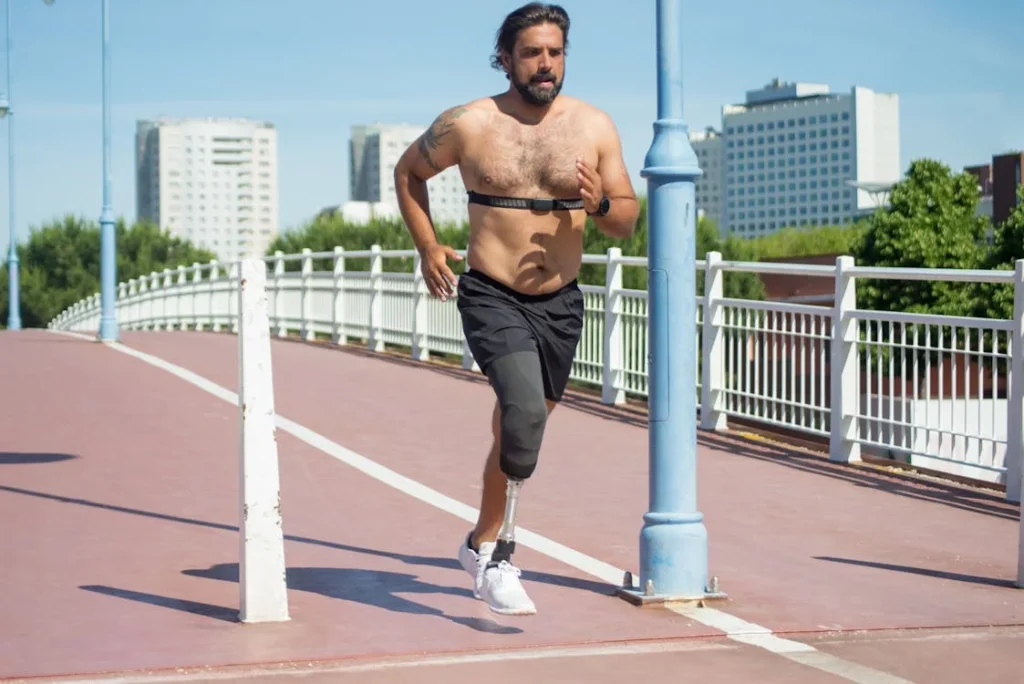Sports prosthetics have come a long way. What once seemed like science fiction is now reality—prosthetic limbs that mimic natural movement, store and release energy, and even adapt to different sports in real time. For amputees, this progress means one thing: fewer limitations, more possibilities.
As we enter 2024, the world of sports prosthetics is advancing faster than ever. Engineers, scientists, and athletes are working together to develop prosthetics that are stronger, lighter, and more intuitive. These innovations are not just improving performance; they are reshaping the way amputees engage in sports, from running and swimming to extreme adventure activities.
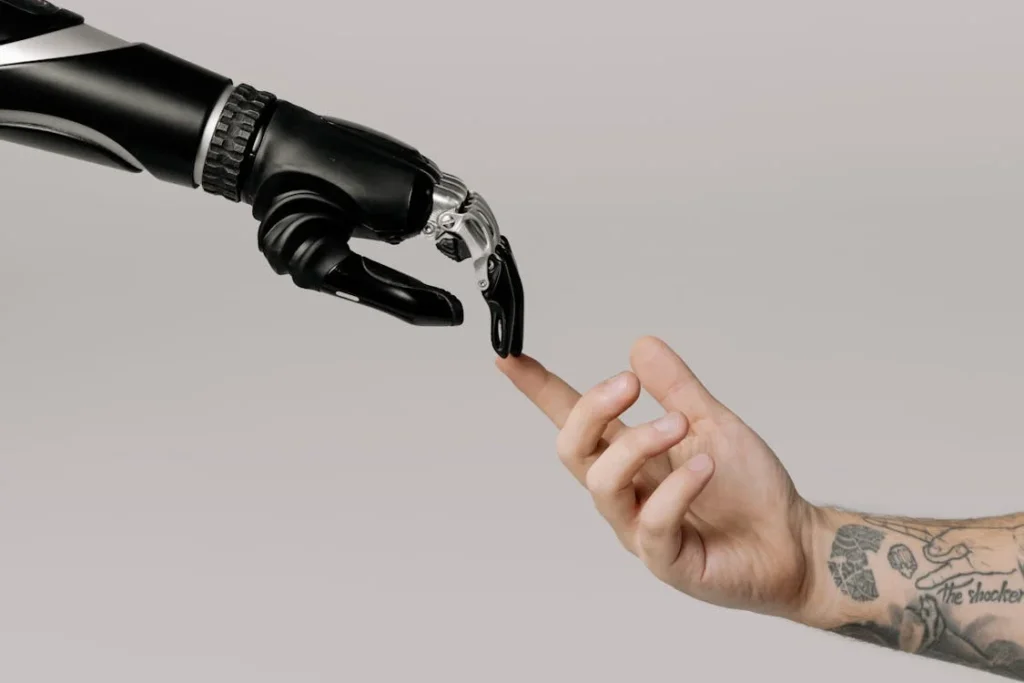
AI and Smart Prosthetics: The Rise of Adaptive Technology
One of the biggest innovations in sports prosthetics for 2024 is the integration of artificial intelligence (AI) and smart sensors. Traditional sports prosthetics rely on mechanical movement, but AI-powered limbs take adaptability to a whole new level.
These advanced prosthetics can learn from an athlete’s movements, adjusting in real time to optimize performance, balance, and control.
How AI is Transforming Sports Prosthetics
AI-enabled prosthetics use a combination of machine learning, motion sensors, and real-time data analysis to understand an athlete’s movement patterns.
This means that instead of a rigid, one-size-fits-all approach, the prosthetic adapts to the user’s specific needs. Whether sprinting, jumping, or cycling, these smart limbs can adjust speed, resistance, and flexibility based on the intensity of the sport.
For example, an AI-powered prosthetic knee can detect the user’s pace and automatically adjust its resistance for smoother motion.
If the athlete is running at high speed, the knee will increase flexibility for longer strides. If the user is walking, it will provide more stability to prevent unnecessary strain.
Some advanced models even use muscle-sensing technology, where tiny sensors placed on the residual limb detect muscle activity. This allows athletes to control their prosthetic more intuitively, creating a natural and fluid experience.
Bionic Limbs with Real-Time Feedback
Another game-changing development is the rise of bionic sports prosthetics with built-in feedback systems. These limbs use haptic feedback and sensory technology to provide users with real-time information about their movements.
For example, an athlete wearing a bionic running blade can receive vibrations or alerts when their stride is uneven, helping them adjust their posture for better efficiency.
Cyclists using smart prosthetic legs can get live feedback on their pedaling rhythm, ensuring they maintain a balanced and powerful motion.
This level of real-time response is making sports prosthetics more intuitive than ever before, allowing athletes to fine-tune their performance with precision.
The Future of AI in Prosthetics
As AI technology continues to evolve, we can expect even more self-learning prosthetics that improve over time. Future prosthetics will not only respond to movement but also predict an athlete’s next move, providing seamless transitions between different activities.
For professional athletes, this could mean highly personalized training programs, where AI prosthetics analyze past performance and suggest improvements. For casual users, it could mean smoother, more natural motion without the need for constant adjustments.
At Robobionics, we believe that AI-driven prosthetics are the future of adaptive sports. As we move into 2024, these innovations are set to redefine what amputee athletes can achieve.
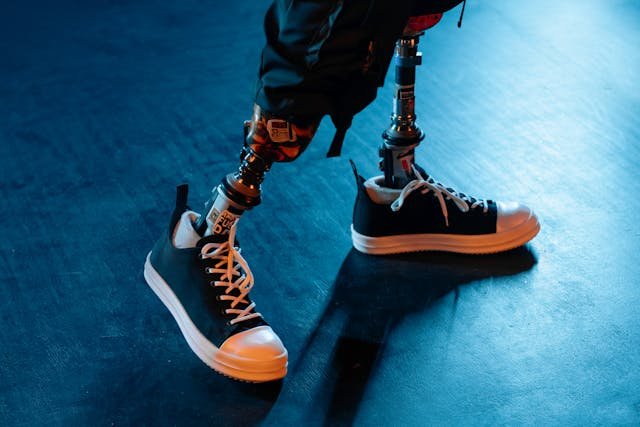
Next-Generation Materials: Lighter, Stronger, and Faster
In the world of sports prosthetics, material innovation is just as important as design. A prosthetic must be lightweight enough to allow for speed and agility, yet strong enough to withstand high-impact activities.
Recent breakthroughs in materials science are making sports prosthetics more durable, flexible, and energy-efficient than ever before.
The Shift to Carbon Fiber and Beyond
For years, carbon fiber has been the gold standard in high-performance prosthetics. It is lightweight, extremely strong, and has excellent energy return, making it ideal for running blades, cycling legs, and sprinting prosthetics.
However, researchers are now developing next-generation carbon composites that offer even greater flexibility and shock absorption without adding extra weight.
One exciting advancement is the use of graphene-infused carbon fiber, which is 200 times stronger than steel while remaining incredibly light.
This material allows for thinner, more responsive prosthetic limbs that maintain durability under intense physical strain. For athletes, this means improved speed, endurance, and comfort, with reduced pressure on their residual limb.
Self-Healing and Temperature-Responsive Prosthetics
Another breakthrough is the development of self-healing materials. Scientists are working on prosthetic components that can repair minor cracks and damage on their own, reducing the need for frequent replacements.
This is especially useful for high-impact sports like football, basketball, and mountain biking, where prosthetic limbs endure constant stress.
Temperature control is also a growing focus. Some advanced materials can expand or contract based on external temperatures, ensuring that the prosthetic remains comfortable in different climates.
This innovation helps athletes who compete in extreme weather conditions, as the prosthetic automatically adjusts for better flexibility in cold temperatures and improved stability in heat.
Bio-Integrated Materials for a Natural Feel
One of the most futuristic developments in prosthetics is bio-integrated materials, which closely mimic the properties of human skin, tendons, and muscles.
These materials are designed to move like real limbs, reducing strain on the body and allowing for more natural motion.
Some advanced prosthetic sockets are even lined with gel-based materials that conform to the user’s residual limb, enhancing comfort and reducing friction.
For high-performance athletes, these innovations mean less fatigue, greater control, and a more intuitive connection between the body and the prosthetic.
Instead of feeling like a separate attachment, the prosthetic limb acts as an extension of the body, responding to movements with incredible accuracy.
How Material Innovation is Reshaping Adaptive Sports
As materials become lighter, stronger, and more adaptive, the performance gap between able-bodied and adaptive athletes is shrinking. These advancements allow amputees to compete at the highest levels, pushing the boundaries of human potential.
At Robobionics, we are closely following these material breakthroughs to bring the best in prosthetic technology to athletes in India and beyond.
By combining cutting-edge materials with smart prosthetic design, we aim to create sports prosthetics that enhance speed, strength, and endurance without compromising comfort.
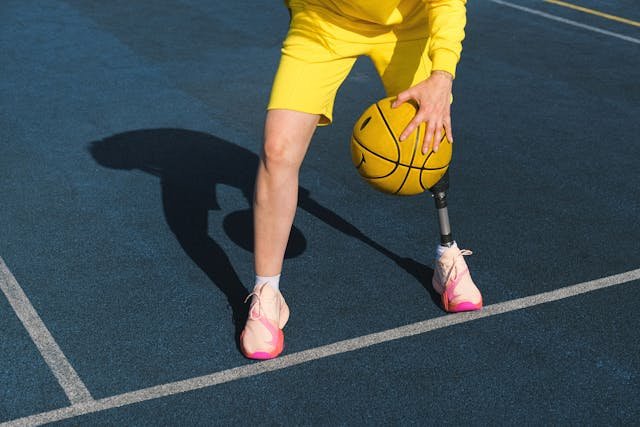
Multi-Sport Prosthetics: One Limb, Multiple Functions
One of the most exciting trends in sports prosthetics for 2024 is the rise of multi-sport prosthetic limbs. Traditionally, amputee athletes have needed different prosthetics for different activities—one for running, another for cycling, and a separate one for swimming.
This has not only been expensive but also inconvenient. New developments in modular and adaptive prosthetics are changing that, making it possible for athletes to transition between multiple sports using a single prosthetic limb.
How Multi-Sport Prosthetics Work
Multi-sport prosthetics use interchangeable components that allow users to switch between different activity modes without replacing the entire limb.
For example, a runner can attach a carbon-fiber running blade for sprinting, then switch to a flat-foot attachment for hiking or weightlifting.
Similarly, cyclists can use angled foot attachments for better pedaling efficiency, then swap them out for a hydrodynamic extension designed for swimming.
Some of the latest smart prosthetic knees are equipped with sensors that automatically adjust resistance based on activity. This means that an athlete who is jogging on a track can suddenly start sprinting, and the knee will respond by increasing flexibility and reducing strain.
If they stop to walk, the knee stiffens to provide better stability. This kind of adaptability makes sports prosthetics more practical for both casual athletes and professionals.
Customizable Prosthetic Sockets for Comfort
Another major advancement in multi-sport prosthetics is the development of customized sockets that adapt to different activities. The prosthetic socket—the part that connects to the residual limb—must fit perfectly to prevent discomfort, irritation, or instability.
New designs are using vacuum-sealed suspension systems and shape-memory materials that adjust to movement, ensuring a snug fit regardless of the sport.
For example, a runner needs a tight, secure socket that keeps the prosthetic stable at high speeds, while a swimmer requires a water-resistant, flexible fit that allows for smooth motion.
New materials are making it possible for a single socket to adjust its tightness and responsiveness based on the pressure and impact of the sport being performed.
The Benefits of Multi-Sport Prosthetics
The biggest advantage of these adaptive prosthetics is that they reduce costs and improve accessibility. Instead of investing in multiple high-performance limbs, athletes can customize one prosthetic for all their needs.
This is especially beneficial for young athletes who are still exploring different sports or those who engage in multiple disciplines, such as triathletes who swim, bike, and run in a single event.
By making sports prosthetics more versatile, affordable, and user-friendly, these innovations are allowing more amputees to participate in diverse physical activities without restrictions.
At Robobionics, we are working towards integrating these modular advancements into our prosthetic designs, ensuring that athletes have access to the best technology for their needs.
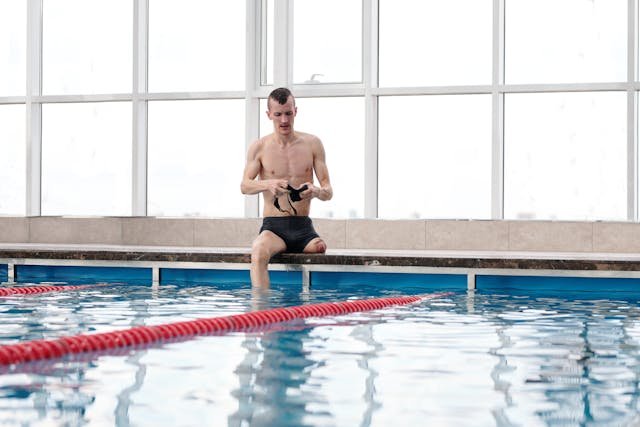
The Role of Biomechanics in Enhancing Sports Prosthetics
The future of sports prosthetics isn’t just about better materials or AI integration—it’s also about understanding how the human body moves.
Biomechanics, the study of movement, plays a crucial role in designing prosthetics that work in harmony with an athlete’s body.
Engineers and scientists are using motion analysis, pressure mapping, and muscle activity tracking to create prosthetics that improve speed, endurance, and comfort.
Creating a More Natural Gait and Motion
One of the main challenges for amputee athletes is achieving a movement pattern that feels and looks natural. Running, jumping, and even simple strides require a complex interaction between muscles, joints, and tendons.
Traditional prosthetics often don’t account for micro-adjustments that the body naturally makes, leading to an unnatural gait or increased strain on other muscles.
Biomechanical research is helping prosthetic manufacturers design limbs that replicate these small, intricate movements.
For example, new shock-absorbing knee joints help runners reduce impact stress, mimicking how a biological knee flexes slightly when the foot strikes the ground.
Similarly, torsion-adaptive footplates allow for better lateral movement, helping soccer or basketball players pivot with more control.
Energy Return Systems for Explosive Power
High-performance athletes, especially sprinters and jumpers, need prosthetics that store and release energy efficiently. Carbon-fiber running blades already offer excellent energy return, but new biomechanical insights are leading to even more efficient designs.
Recent developments in variable stiffness materials allow a prosthetic to adjust its stiffness based on the force applied.
This means that a runner who needs explosive power at takeoff can get more spring from their prosthetic, while a distance runner who needs long, efficient strides will experience less energy loss over time.
Additionally, multi-directional energy return systems are being developed to help athletes in sports like long jump, high jump, and triple jump, where movement isn’t just linear but also vertical.
These advancements are allowing adaptive athletes to compete at levels previously thought impossible.
Reducing Fatigue and Injury Risk
One of the biggest concerns for amputee athletes is the risk of overuse injuries. When a prosthetic doesn’t align perfectly with the body’s natural movement, it can lead to muscle imbalances, joint strain, and long-term fatigue.
Biomechanics research is helping prosthetic designers create limbs that reduce these risks by distributing impact forces more evenly.
For example, new prosthetic knee designs use fluid-dynamic resistance, which adapts to different speeds and terrains, helping to reduce the strain on the hip and lower back.
Additionally, AI-driven biomechanics analysis is being used to provide real-time adjustments.
Some advanced prosthetics now feature sensor-based feedback that alerts athletes when their posture or stride is putting excessive stress on certain areas, allowing them to correct their form before an injury develops.
The Future of Biomechanics in Prosthetics
As research in biomechanics continues, prosthetics will become more than just artificial limbs—they will function as true extensions of the human body.
By designing limbs that work with an athlete’s natural movement patterns, these innovations will allow amputees to move faster, jump higher, and perform with less strain and fatigue.
At Robobionics, we are committed to integrating the latest biomechanical insights into our sports prosthetics. By combining science, engineering, and real-world athlete feedback, we are creating prosthetic solutions that maximize comfort, efficiency, and performance.
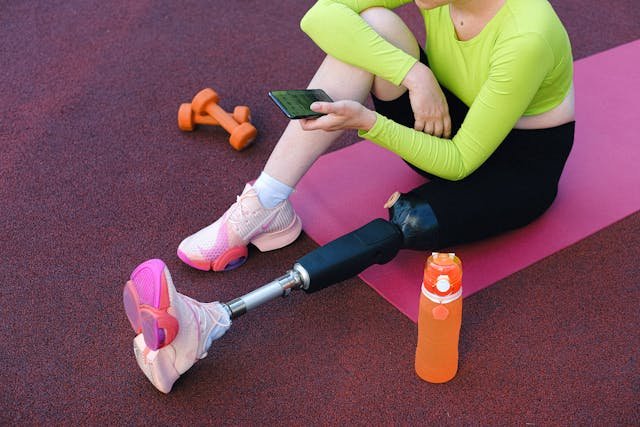
The Growing Accessibility of Sports Prosthetics
As technology advances, one of the most exciting shifts in sports prosthetics is increased accessibility. In the past, high-performance prosthetic limbs were often expensive and difficult to obtain, limiting opportunities for many amputees.
However, innovations in manufacturing, funding, and distribution are making state-of-the-art prosthetics more affordable and available to athletes around the world.
3D Printing: Making Prosthetics More Affordable
One of the biggest breakthroughs in accessibility is 3D printing technology. Traditional prosthetic manufacturing is time-consuming and costly, often requiring weeks of custom molding and assembly.
3D printing has changed the game by allowing for faster, more affordable production of custom prosthetics.
This innovation is especially important for young athletes, whose bodies are still growing and require frequent prosthetic adjustments.
Instead of replacing an entire limb, 3D printing allows for quick modifications and replacements, ensuring that young athletes always have a properly fitted limb without high costs.
Additionally, 3D-printed materials are becoming lighter and stronger, making them a viable alternative to traditional carbon fiber models.
Some advanced 3D-printed prosthetics now include flexible joints and shock-absorbing structures, improving performance in sports like running, cycling, and basketball.
Funding and Sponsorship for Adaptive Athletes
Another major barrier to sports prosthetics has been cost, but more funding options are emerging. Governments, nonprofit organizations, and private companies are increasingly supporting adaptive athletes through grants, sponsorships, and crowdfunding platforms.
Organizations like the Paralympic Committee of India and various global sports foundations are working to bridge the gap between athletes and high-performance prosthetics.
Many manufacturers are also offering payment plans and financial assistance, ensuring that more amputees can access the technology they need.
Private sponsorships are becoming more common as well. As adaptive sports gain more media attention, companies are investing in athletes who inspire global audiences, helping them acquire cutting-edge prosthetics for training and competition.
Expanding Availability Through Localized Manufacturing
Previously, high-performance prosthetics were mostly developed in Western countries, making it difficult for athletes in other parts of the world—especially in developing countries—to access the latest innovations. Today, localized manufacturing is changing that.
Companies like Robobionics are focusing on “Made in India” prosthetics, ensuring that athletes in the country have access to world-class technology without long wait times or excessive costs. By producing prosthetics locally, athletes benefit from:
- Faster customizations and repairs
- Lower costs compared to imported models
- Easier access to maintenance and adjustments
This shift towards regional production means that more amputees, even in rural areas, can participate in sports without worrying about whether they can afford or maintain a high-quality prosthetic.
A Future Where Every Amputee Can Compete
The combination of cheaper production methods, better funding, and wider availability is creating a future where no amputee is left behind.
Whether someone wants to run their first race, cycle through the city, or train for the Paralympics, access to high-performance prosthetics is becoming less about financial status and more about passion and determination.
At Robobionics, we are committed to making sports prosthetics affordable, accessible, and tailored for real-world athletes. Our goal is simple: to ensure that anyone with a dream to compete can do so, without barriers.
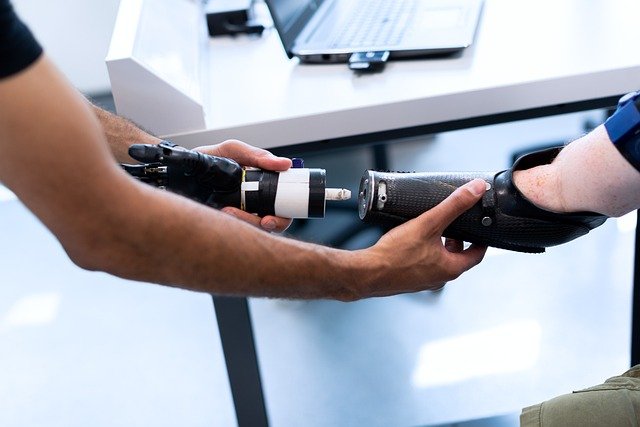
The Role of Sports Science in Prosthetic Development
As sports prosthetics evolve, the collaboration between engineers, prosthetists, and sports scientists is becoming more critical than ever.
Prosthetic technology alone isn’t enough—understanding how the human body interacts with these devices is key to unlocking better performance.
Sports science is now shaping the future of prosthetic design by focusing on movement analysis, injury prevention, and customized training programs for adaptive athletes.
Optimizing Performance Through Data-Driven Training
Elite athletes rely on sports science labs to analyze every aspect of their performance, from stride length to muscle activation patterns.
Today, the same level of precision is being applied to prosthetic users. Motion-capture technology, force sensors, and biomechanical tracking systems are helping researchers fine-tune prosthetics for maximum efficiency.
For example, pressure mapping systems can detect uneven weight distribution in a runner’s stride. If an athlete is putting more force on their intact leg, their prosthetic can be adjusted to promote a more balanced gait.
Similarly, wearable sensors can provide real-time feedback on posture, cadence, and energy efficiency, helping athletes refine their technique.
Coaches and trainers working with adaptive athletes can now use AI-powered performance analysis software to track progress and create personalized workout routines.
This approach ensures that athletes don’t just have the best prosthetics—they also develop the best movement patterns to enhance speed, endurance, and injury resistance.
Preventing Overuse Injuries in Adaptive Athletes
One of the biggest concerns for amputee athletes is overuse injuries. Unlike able-bodied competitors, prosthetic users often place extra strain on specific muscle groups to compensate for lost limbs.
This imbalance can lead to long-term issues like joint pain, tendon inflammation, and spinal misalignment.
Sports scientists are now focusing on injury prevention strategies tailored specifically for adaptive athletes. By analyzing muscle engagement during different activities, they can identify areas of weakness and suggest targeted strength training exercises.
For example, a long-distance runner using a blade prosthetic might need additional core stabilization exercises to prevent hip fatigue, while a cyclist might require hip flexor training to maintain smooth pedaling mechanics.
Additionally, dynamic prosthetic alignment techniques are being used to reduce stress on the residual limb.
Traditional prosthetics often force athletes into rigid movement patterns, but newer models adjust dynamically to distribute impact forces more evenly across the body. This helps reduce strain and allows for longer, pain-free training sessions.
Adapting Training for Different Sports
Prosthetic technology alone won’t turn an amputee into an elite athlete—proper training plays a major role. Sports scientists are now working on adaptive training methodologies that take into account the unique biomechanics of prosthetic users.
For sprinters, this might involve explosive power drills that maximize the energy return from a running blade. For swimmers, specialized training focuses on upper body propulsion to compensate for different leg movements in the water.
Weightlifters using prosthetic limbs may need customized grip attachments to ensure stability and safety during heavy lifts.
By combining prosthetic advancements with scientific training methods, athletes can unlock their full potential and compete at levels that were once thought impossible.
The Future of Sports Science and Prosthetics
The growing relationship between sports science and prosthetic technology is leading to more personalized, data-driven, and effective solutions for adaptive athletes.
In the future, we can expect to see fully integrated smart prosthetics that track movement, provide feedback, and adapt automatically based on performance data.
At Robobionics, we believe in combining cutting-edge prosthetic technology with the latest sports science research to help athletes reach new heights.
By focusing on both equipment and training, we ensure that every athlete has the tools and knowledge needed to compete without limits.
Conclusion
The world of sports prosthetics is evolving at an incredible pace. With AI-powered limbs, advanced materials, multi-sport adaptability, and sports science integration, amputee athletes now have more opportunities than ever to push their limits. These innovations are not just improving performance—they are breaking barriers, making high-quality prosthetics more accessible, and redefining what’s possible in adaptive sports.
As technology continues to advance, we are moving toward a future where prosthetic limbs are not just replacements but performance-enhancing tools that work in harmony with the body. From smarter, self-adjusting knees to ultra-lightweight energy-return materials, the next generation of sports prosthetics will empower athletes to run faster, jump higher, and compete at elite levels.
At Robobionics, we are dedicated to bringing these innovations to real-world athletes, ensuring that anyone with a passion for sports can access the best prosthetic solutions. Whether you’re a beginner or an elite competitor, the future is bright—and it’s built for you.
Ready to take the next step in your sports journey? Contact us today and discover how the latest prosthetic innovations can help you achieve your goals!



